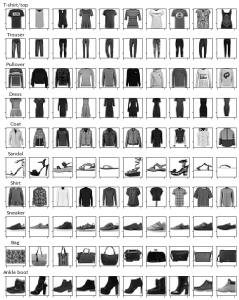最近受けている講座の中で、kerasに同梱されているデータセットの中に、Fashion-MNISTという画像データがあることを知りました。
画像データを使って機械学習を試す時(と言っても、自分が画像データを扱うことはほぼないのですが)は、
大抵手書き数字のMNISTデータを使っていて、いささか飽きていたので、早速これを確認してみました。
ドキュメントはこちら。
Fashion-MNIST database of fashion articles
手書き数字のMNISTと完全互換らしく、クラス数は10個、画像サイズは28*28、データ件数も訓練データ60,000とテストデータ10,000のデータになっています。
読み込みもほぼ同じです。
今回はデータセットの紹介なので、読み込んで実際に画像を表示してみるところまでやってみます。
from tensorflow.keras.datasets import fashion_mnist
import matplotlib.pyplot as plt
(x_train, y_train), (x_test, y_test) = fashion_mnist.load_data()
print("x_train.shape: ", x_train.shape)
print("y_train.shape: ", y_train.shape)
print("x_test.shape: ", x_test.shape)
print("y_test.shape: ", y_test.shape)
"""
x_train.shape: (60000, 28, 28)
y_train.shape: (60000,)
x_test.shape: (10000, 28, 28)
y_test.shape: (10000,)
"""
# 0〜9が どんなアイテムに対応しているかの対応はdatasetに含まれないので別途作る
target_name = {
0: "T-shirt/top",
1: "Trouser",
2: "Pullover",
3: "Dress",
4: "Coat",
5: "Sandal",
6: "Shirt",
7: "Sneaker",
8: "Bag",
9: "Ankle boot",
}
fig = plt.figure(figsize=(10, 13), facecolor="w")
for i in range(100):
ax = fig.add_subplot(10, 10, i+1)
ax.set_xticklabels([])
ax.set_yticklabels([])
ax.imshow(x_train[y_train == i // 10][i % 10], cmap="gray_r")
if i % 10 == 0:
# アイテムの最初の画像にタイトルつける
ax.set_title(target_name[i//10])
plt.show()
結果として表示される画像がこちらです。
手書き数字のMNISTよりちょっと楽しそうなデータですね。
そして結構難易度たかそうです。
